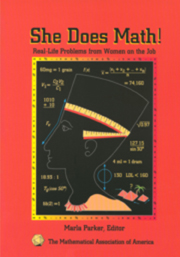Book contents
- Frontmatter
- Preface
- Contents
- Problems by Subject
- Environmental Psychology
- Software Engineering; Computer Science
- Archaeology
- Mathematics and Computer Science
- Civil Engineering
- Mathematics
- Electrical Engineering
- Physics; X-ray Astronomy Research
- Mathematics
- Physics; Astronaut Crew Training Instructor
- Business Data Processing
- Software Engineering; Real Estate Investment
- Quality Engineering
- Health Science
- Nursing Education
- Electrical Engineering; Space Systems
- Oil and Gas Accounting
- Business Administration Higher Education
- Aerospace Engineering
- Structural Engineering
- Computer Science
- Mathematics
- Dietetics—Foodservice Management and Nutrition
- Electrical Engineering
- Chemical Engineering, retired
- Software Engineering
- Immunology and Microbiology
- Mechanical Engineering
- HMO Pharmacy Practice and Management
- Ophthalmology
- Electrical Engineering
- Fish Pathology
- Computer Science and Computer Graphics
- Mathematics and Computing
- Electrical Engineering
- Astronomy
- Author
- Mathematics
- Reflections on WAM
- Solutions
Archaeology
- Frontmatter
- Preface
- Contents
- Problems by Subject
- Environmental Psychology
- Software Engineering; Computer Science
- Archaeology
- Mathematics and Computer Science
- Civil Engineering
- Mathematics
- Electrical Engineering
- Physics; X-ray Astronomy Research
- Mathematics
- Physics; Astronaut Crew Training Instructor
- Business Data Processing
- Software Engineering; Real Estate Investment
- Quality Engineering
- Health Science
- Nursing Education
- Electrical Engineering; Space Systems
- Oil and Gas Accounting
- Business Administration Higher Education
- Aerospace Engineering
- Structural Engineering
- Computer Science
- Mathematics
- Dietetics—Foodservice Management and Nutrition
- Electrical Engineering
- Chemical Engineering, retired
- Software Engineering
- Immunology and Microbiology
- Mechanical Engineering
- HMO Pharmacy Practice and Management
- Ophthalmology
- Electrical Engineering
- Fish Pathology
- Computer Science and Computer Graphics
- Mathematics and Computing
- Electrical Engineering
- Astronomy
- Author
- Mathematics
- Reflections on WAM
- Solutions
Summary
Ever since I was in junior high school, I have been interested in archaeology and the mysteries of the past. It's fascinating to learn how archaeologists decipher the past from sparse clues—broken pottery, abandoned homes, trash middens—and how they employ many of the same strategies as detectives.
In school, I was neutral towards math; I didn't like it, but I didn't strongly dislike it either … until high school, when I took geometry, trigonometry, and college algebra. I wasn't good at these subjects, and the C's and B's I received in these classes pulled my grade point average down. After that, I avoided taking any more math.
By tenth grade, I already wanted to be an archaeologist, so I took several elective humanities courses and read as much as I could about the subject. Archaeology is usually thought of as a social science, and in those days (the early 1970s), statistical analyses weren't widely utilized in the field. I felt very comfortable with my career choice, partly because it didn't necessitate taking higher math courses. During my undergraduate years, I was successful at avoiding higher math, earning a BA in anthropology from Pennsylvania State University in 1975.
But by the time I got to graduate school in 1981, there was no way around statistics and computer science courses. Archaeological fieldwork generates enormous amounts of data. Computer manipulation and statistical analyses of the data are the only means to make sense of it.Severe math anxiety was upon me! I had no choice but to nervously plunge in.
- Type
- Chapter
- Information
- She Does Math!Real-Life Problems from Women on the Job, pp. 7 - 13Publisher: Mathematical Association of AmericaPrint publication year: 1995



